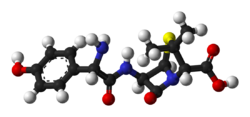- Amoxicillin
-
Amoxicillin 

Systematic (IUPAC) name (2S,5R,6R)- 6-{[(2R)-2-amino- 2-(4-hydroxyphenyl)- acetyl]amino}- 3,3-dimethyl- 7-oxo- 4-thia- 1-azabicyclo[3.2.0]heptane- 2-carboxylic acid Clinical data Trade names Actimoxi, Alphamox, Amocla, Amoxil, Trimox, among others AHFS/Drugs.com monograph MedlinePlus a685001 Pregnancy cat. A(AU) B(US) Legal status POM (UK) Routes Oral, intravenous Pharmacokinetic data Bioavailability 95% oral Metabolism less than 30% biotransformed in liver Half-life 61.3 minutes Excretion renal Identifiers CAS number 26787-78-0 
ATC code J01CA04 QG51AX01 PubChem CID 33613 DrugBank DB01060 ChemSpider 31006 
UNII 9EM05410Q9 
KEGG D07452 
ChEBI CHEBI:2676 
ChEMBL CHEMBL1082 
Chemical data Formula C16H19N3O5S Mol. mass 365.4 g/mol SMILES eMolecules & PubChem  (what is this?) (verify)
(what is this?) (verify)Amoxicillin (INN), formerly amoxycillin (BAN), and abbreviated amox, is a moderate-spectrum, bacteriolytic, β-lactam antibiotic used to treat bacterial infections caused by susceptible microorganisms. It is usually the drug of choice within the class because it is better absorbed, following oral administration, than other β-lactam antibiotics. Amoxicillin is one of the most common antibiotics prescribed for children.
Amoxicillin is susceptible to degradation by β-lactamase-producing bacteria, which are resistant to a broad spectrum of β-lactam antibiotics, such as penicillin. For this reason, it is often combined with clavulanic acid, a β-lactamase inhibitor, and marketed under one name. This increases effectiveness by reducing its susceptibility to β-lactamase resistance.
Contents
Medical uses
Amoxicillin is used in the treatment of a number of infections including: acute otitis media, streptococcal pharyngitis, pneumonia, skin infections, urinary tract infections, salmonella, lyme disease, and chlamydia infections.[1] It is used to prevent bacterial endocarditis in high risk people who are having dental work done, to prevent strep pneumococus infections in those without a spleen, and for both the prevention and treatment of anthrax.[1] It is also a treatment for cystic acne.[2] The UK however does not recommend its use for infectious endocarditis prophylaxis.[3] These recommendations have not appeared to have changed the rates of infection.[4]
Adverse effects
Side-effects are as those for other beta-lactam antibiotics. Side-effects include nausea, vomiting, rashes, and antibiotic-associated colitis. Loose bowel movements (diarrhea) also may occur. Rarer, but patient-reported, side-effects include mental changes, lightheadedness, insomnia, confusion, anxiety, sensitivity to lights and sounds, and unclear thinking. Immediate medical care is required upon the first signs of these side-effects.
The onset of an allergic reaction to amoxicillin can be very sudden and intense - emergency medical attention must be sought as quickly as possible. The initial onset of such a reaction often starts with a change in mental state, skin rash with intense itching (often beginning in fingertips and around groin area and rapidly spreading), and sensations of fever, nausea, and vomiting. Any other symptoms that seem even remotely suspicious must be taken very seriously. However, more mild allergy symptoms, such as a rash, can occur at any time during treatment, even up to a week after treatment has ceased. For some people who are allergic to amoxicillin the side effects can be deadly.
Use of the amoxicillin/clavulanic acid combination for more than one week has caused mild hepatitis in some patients. Young children having ingested acute overdoses of amoxicillin manifested lethargy, vomiting and renal dysfunction.[5][6]
Nonallergic amoxicillin rash
See also: Stevens–Johnson syndromeSomewhere between 3% and 10% of children taking amoxicillin (or ampicillin) show a late-developing (>72 hours after beginning medication and having never taken penicillin-like medication previously), often itchy rash, which is sometimes referred to as the "amoxicillin rash." The rash can also occur in adults.
The rash is described as maculopapular or morbilliform (measles-like; therefore, in medical literature, it is called "amoxicillin-induced morbilliform rash"[7]). It starts on the trunk and can spread from there. This rash is unlikely to be a true allergic reaction, and is not a contraindication for future amoxicillin usage, nor should the current regimen necessarily be stopped. However, this common amoxicillin rash and a dangerous allergic reaction cannot easily be distinguished by inexperienced persons, and therefore a healthcare professional is often required to distinguish between the two.[8]
A nonallergic amoxicillin rash may also be an indicator of infectious mononucleosis: Some studies indicate approximately 80-90% of patients with acute Epstein Barr virus infection treated with amoxicillin or ampicillin develop such a rash.[9]
Interaction
Amoxicillin may interact with the following groups of drugs:
- Anticoagulants (e.g. warfarin, pradaxa)[10]
- Allopurinol (gout treatment)
- Birth control pills
- Certain antibiotics
- Cancer treatment (methotrexate)
- Uricosuric drugs
- Typhoid vaccine
Mechanism of action
This drug acts by inhibiting the synthesis of bacterial cell walls. It inhibits cross-linkage between the linear peptidoglycan polymer chains that make up a major component of the cell walls of both Gram-positive and Gram-negative bacteria.
It has two ionizable groups in the physiological range (the amino group in alpha-position to the amide carbonyl group and the carboxyl group).
Formulations
Modes of delivery
Pharmaceutical manufacturers make amoxicillin in trihydrate form available as capsules, chewable and dispersible tablets plus syrup and pediatric suspension for oral use, and as the sodium salt for intravenous administration (although the IV formulation is not available in the United States[11]).
Amoxicillin is most commonly taken orally. The liquid forms are helpful where the patient might find it difficult to take tablets or capsules.
Research with mice (published in 2010) indicates successful delivery using intraperitoneally injected amoxicillin-bearing microparticles.[12]
Proprietary preparations
Amoxicillin is one of the semisynthetic penicillins discovered by Beecham scientists. The patent for amoxicillin has expired, thus amoxicillin is marketed under many trade names, including: Actimoxi, Alphamox, Amocla, AMK, Amoksibos, Amoxiclav Sandoz, Amoxidal, Amoxil, Amoxin, Amoksiklav (with clavulanic acid), Amoxibiotic, Amoxicilina, Amoxidal, Apo-Amoxi, Augmentin (with clavulanic acid), Bactox, Betalaktam, Bioxidona, Cilamox, Clamoxyl, Curam, Dedoxil, Dispermox, Duomox, E-Mox, Enhancin, Gimalxina, Geramox, Hiconcil, Isimoxin, Klavax, Klavocin, Klavox, Lamoxy, Largopen, Moxatag, Moxilen, Moxypen, Moxyvit, Nobactam, Novamoxin, Ospamox, Panklav (with clavulanic acid),Optamox, Pamoxicillin, Panamox, Polymox, Samthongcillin, Senox, Sinacilin, Starmox, Trimox, Tolodina, Tormoxin, Wedemox, Wymox, Yucla, Zerrsox and Zimox.
References
- ^ a b "Amoxicillin". The American Society of Health-System Pharmacists. http://www.drugs.com/monograph/amoxicillin.html. Retrieved 3 April 2011.
- ^ "Adolescent Acne: Management". http://www.medscape.com/viewarticle/430534_5.
- ^ "CG64 Prophylaxis against infective endocarditis: Full guidance". NICE. http://www.nice.org.uk/nicemedia/live/11938/40039/40039.pdf. Retrieved 8 June 2011.
- ^ Thornhill, MH; Dayer, MJ, Forde, JM, Corey, GR, Chu, VH, Couper, DJ, Lockhart, PB (2011 May 3). "Impact of the NICE guideline recommending cessation of antibiotic prophylaxis for prevention of infective endocarditis: before and after study". BMJ (Clinical research ed.) 342: d2392. doi:10.1136/bmj.d2392. PMC 3086390. PMID 21540258. http://www.pubmedcentral.nih.gov/articlerender.fcgi?tool=pmcentrez&artid=3086390.
- ^ Cundiff J, Joe S. Amoxicillin-clavulanic acid-induced hepatitis. Amer. J. Otolaryngol. 28: 28-30, 2007.
- ^ R. Baselt, Disposition of Toxic Drugs and Chemicals in Man, 8th edition, Biomedical Publications, Foster City, CA, 2008, pp. 81-83.
- ^ "Role of delayed cellular hypersensitivity and adhesion molecules in amoxicillin-induced morbilliform rashes". Cat.inist.fr. http://cat.inist.fr/?aModele=afficheN&cpsidt=2654598. Retrieved 2010-11-13.
- ^ (Pichichero, 2005; Schmitt 2005)
- ^ Kagan, B (1977). "Ampicillin rash". Western Journal of Medicine 126 (4): 333–335. PMC 1237570. PMID 855325. http://www.pubmedcentral.nih.gov/articlerender.fcgi?tool=pmcentrez&artid=1237570.
- ^ British National Formulary 57 March 2009
- ^ www.UpToDate.com
- ^ Amoxicillin bearing microparticles: potential in treatment of Listeria monocytogenes infection in Swiss albino mice, Bioscience reports immediate publication, 2010-08-05, manuscript BSR 20100027
Further reading
- GlaxoSmithKline (February 2006). "Amoxil - Prescribing information" (PDF). http://us.gsk.com/products/assets/us_amoxil.pdf.
- Neal, M. J. (2002). Medical pharmacology at a glance (4th ed.). Oxford: Blackwell Science. ISBN 0-632-05244-9.
- Pichichero ME (April 2005). "A review of evidence supporting the American Academy of Pediatrics recommendation for prescribing cephalosporin antibiotics for penicillin-allergic patients". Pediatrics 115 (4): 1048–57. doi:10.1542/peds.2004-1276. PMID 15805383. http://pediatrics.aappublications.org/cgi/content/full/115/4/1048.
- Schmitt, Barton D. (2005). Your child's health: the parents' one-stop reference guide to symptoms, emergencies, common illnesses, behavior problems, healthy development (2nd ed.). New York: Bantam Books. ISBN 0-553-38369-8.
- British National Formulary 45 March 2003
External links
- University of Michigan Mott's Children's Hospital article about "amoxicillin rash." (Very similar to Schmitt 2005 content)[dead link]
- U.S. National Library of Medicine: Drug Information Portal - Amoxicillin
Categories:- Beta-lactam antibiotics
- Enantiopure drugs
- GlaxoSmithKline
- World Health Organization essential medicines
- Phenols
Wikimedia Foundation. 2010.





